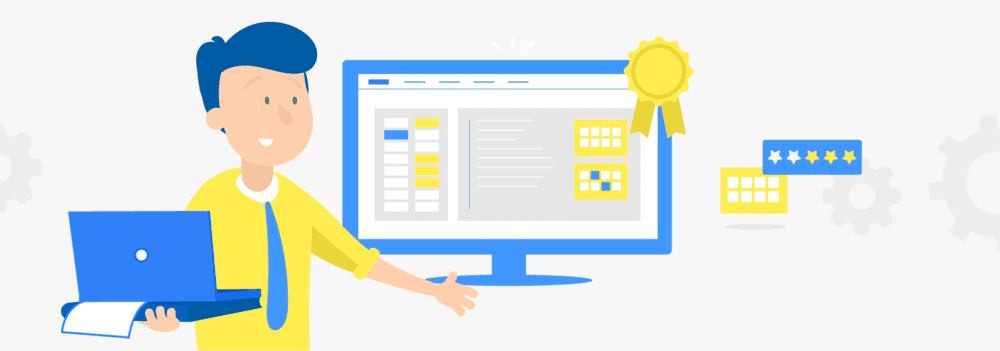Why upskilling is key for the future of work
During this article, we discuss upskilling and its significance for the future of work. It examines the importance of ongoing skill development in navigating evolving workforce trends and technological advancements.

In recent years, upskilling has become a significant phrase in the HR vocabulary. But what is upskilling, and what does it mean?
Also, is there a certain way to implement a workforce upskilling strategy and how? What’s more, discover why it’s not only crucial for employee retention rates but business growth and development.
The basics: firstly, what is upskilling vs. reskilling?Copied
Upskilling is the process of taking your skills and knowledge in a certain area to a new level, while the term reskilling involves learning new skills so you can do a different job. Upskilling primarily focuses on helping employees become more skilled and relevant at their current position within the organization.
According to a report published by Gallup, the cost of replacing an individual employee can range from one and a half to two times the employee’s annual salary—and that’s a conservative estimate. This means a 100-person organization that provides an average salary of $50,000 could have turnover and replacement costs of approximately $660,000 to $2.6 million per year.
Upskilling is a much smaller investment than hiring and training a new worker. As you reskill employees’, you create a more well-rounded, cross-trained workforce, that can increase your team’s effectiveness. So, why is upskilling crucial for future workplace development?
How to upskill your workforce Copied
The following upskilling examples offer some methods for continued Learning and Development (L&D) in the workplace.
The most effective upskilling strategies incorporate several techniques that make the most of existing internal skills and external resources. Each business must align its methods with its business objectives and requirements. Also, remember to consider different learning styles and balance these against individual employees’ needs.
Tip: Discover a range of learning styles that can help!

Copied
Continuous trainingCopied
The most efficient way of upskilling in the workplace is simply by the level of accountability or broadening the workload to a member of staff. This is best achieved by asking senior employees to act as mentors, or by bringing separate departments together to operate collaboratively (peer-to-peer mentoring and training).
E-learning
If you’re looking to upskill employees in the workplace, online e-learning platform-tools offer a manageable and cost-effective upskilling strategy. There are online e-learning platforms for just about every business sector and industry, offering cutting-edge resources that offer verified qualifications. Employees’ can study at their own pace from their desk, eliminating travel costs, and time spent away from the office making it a flexible option to consider.
Seminars/Webinars
Allowing employees time away from the office to attend relevant seminars or participate in a webinar is another successful upskilling strategy. As well as gaining exposure to industry trends and learning from sector heads, they will also have the chance to network with their industry peers.
Upskilling & reskilling – what are the differences?Copied
While both sound similar, they both have different roles and purposes within L&D strategies. Let’s find out how!
Upskilling
To upskill is to implement training that improves an employee’s existing skillset, allowing them to progress in their current role and bring added value to a company.
Reskilling
To reskill is to primarily retrain a member of staff for a new job role. This method is generally used when an employee’s job has become non-essential, and the employer looks to retain the employee by training them in a different discipline.
The answer: Although mainly associated with advancements in technology, upskilling and reskilling are also vital for the highly-competitive and evolving business environment, making them both equally critical elements of a powerful business strategy.
Why is upskilling more crucial than ever?Copied
Essentially, upskilling is key for the future of workplace growth and staff retention rates. A report from McKinsey & Company states that if organizations undertake upskilling/reskilling during the global COVID-19 pandemic, they can emerge stronger from the crisis.
Upskilling the workforce will not only mean you stand out from industry competition by having agile, diverse, and creative employees that are continuously learning, adapting, and acquiring new skills but can avoid financial pitfalls through recruiting new employees.
Upskilling current staff members is an indispensable practice to retain staff and save external hiring costs. Want to know how upskilling can encourage business growth and employee retention rates? Let’s take a look at why it’s so crucial and how skills management software is the answer…

Why skills management software is your new best friend!Copied
Skills management software is used to analyze and identify the gap between the skills needed for the continued growth and success of an organization, and the skills that are offered by its current workforce.
Skills management software matrices bring many benefits to an organization. Here are a few examples:
- Succession planning – An organization can create an outline of internal progress, ensuring relevant skills are retained by potential replacements.
- Future-proofing – A company can assess the direction of its industry and the appropriate skill sets required in order to remain competitive.
- Individual career paths – A company can ensure employees continue to develop the skills needed for their personal goals, consequently increasing staff retention rates through job fulfillment.
What’s more, skills matrices are crucial in delivering a successful upskilling strategy – helping to highlight skill weaknesses and the required training indications to achieve the desired results.
This is where AG5 can benefit your company greatly! As an easy-to-use centralized skill software tool, it not only provides multiple templates for several teams/departments but reduces the time spent on inputting data.
- The insights you gather from skills matrices give managers a clearer picture of their employees.
- It also makes describing skills more straightforward and then matching them effectively.
- Another perspective is that it actively involves staff in your skill/upskilling evaluation. This also makes it easier for you to have greater productive discussions, providing insights and reflections.
Use AG5 to identify skill gaps
Say goodbye to Excel matrices. Start using AG5’s plug and play skill matrix software.
ISO27001 certified
Start your 14-day free trial

